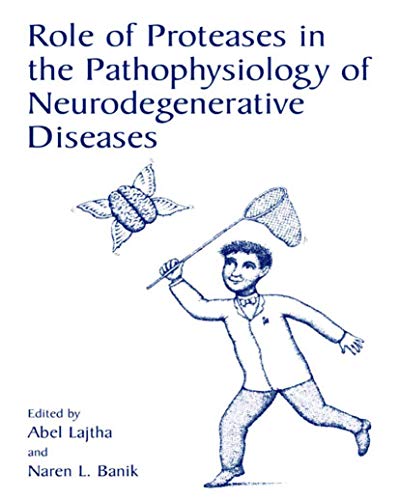Items related to Role of Proteases in the Pathophysiology of Neurodegenerativ...

"synopsis" may belong to another edition of this title.
"About this title" may belong to another edition of this title.
- PublisherSpringer
- Publication date2001
- ISBN 10 0306465795
- ISBN 13 9780306465796
- BindingHardcover
- Number of pages316
- EditorLajtha Abel, Banik Naren L.
Buy New
Learn more about this copy
Shipping:
FREE
Within U.S.A.
Top Search Results from the AbeBooks Marketplace
Role of Proteases in the Pathophysiology of Neurodegenerative Diseases by Friedman, Herman, Honeyman, Allen, Lajtha, Able, Katz, Lynda J., Bendinelli, Mauro, Weisman, Newland, Robert, goldstein, Gerald, Beers, Sue R., Howie, Alexander J., Lance, Leonard L., Lacy, Charles F., Goldman, Morton P., Young, David B. [Hardcover ]
Book Description Hardcover. Condition: new. Seller Inventory # 9780306465796
Role of Proteases in the Pathophysiology of Neurodegenerative Diseases
Book Description Buch. Condition: Neu. This item is printed on demand - it takes 3-4 days longer - Neuware -Researchers seeking problems that offer more hope of success often avoid subjects that seem to be difficult to approach experimentally, or subjects for which experimental results are difficult to interpret. The breakdown part of protein turnover in vivo, particularly in nervous tissue, was such a subject in the past - it was difficult to measure and difficult to explore the mechanisms involved. For factors that influence protein metabolism, it was thought that protein content, function, and distribution are controlled only by the synthetic mechanisms that can supply the needed specificity and response to stimuli. The role of breakdown was thought to be only a general metabolic digestion, elimination of excess polypeptides. We now know that the role of breakdown is much more complex: it has multiple functions, it is coupled to turnover, and it can affect protein composition, function, and synthesis. In addition to eliminating abnormal proteins, breakdown has many modulatory functions: it serves to activate and inactivate enzymes, modulate membrane function, alter receptor channel properties, affect transcription and cell cycle, form active peptides, and much more. The hydrolysis of peptide bonds often involves multiple steps, many enzymes, and cycles (such as ubiquination), and often requires the activity of enzyme complexes. Their activation, modification, and inactivation can thus play an important role in biological functions, with numerous families of proteases participating. The specific role of each remains to be elucidated. 320 pp. Englisch. Seller Inventory # 9780306465796
Role of Proteases in the Pathophysiology of Neurodegenerative Diseases
Book Description Condition: New. PRINT ON DEMAND Book; New; Fast Shipping from the UK. No. book. Seller Inventory # ria9780306465796_lsuk
Role of Proteases in the Pathophysiology of Neurodegenerative Diseases
Book Description Gebunden. Condition: New. Dieser Artikel ist ein Print on Demand Artikel und wird nach Ihrer Bestellung fuer Sie gedruckt. Dr. Lajtha is the editor of the Journal of Neurochemical Research.Researchers seeking problems that offer more hope of success often avoid subjects that seem to be difficult to approach experimentally, or subjects for which experimental results. Seller Inventory # 5903257
Role of Proteases in the Pathophysiology of Neurodegenerative Diseases
Book Description Buch. Condition: Neu. Druck auf Anfrage Neuware - Printed after ordering - Researchers seeking problems that offer more hope of success often avoid subjects that seem to be difficult to approach experimentally, or subjects for which experimental results are difficult to interpret. The breakdown part of protein turnover in vivo, particularly in nervous tissue, was such a subject in the past - it was difficult to measure and difficult to explore the mechanisms involved. For factors that influence protein metabolism, it was thought that protein content, function, and distribution are controlled only by the synthetic mechanisms that can supply the needed specificity and response to stimuli. The role of breakdown was thought to be only a general metabolic digestion, elimination of excess polypeptides. We now know that the role of breakdown is much more complex: it has multiple functions, it is coupled to turnover, and it can affect protein composition, function, and synthesis. In addition to eliminating abnormal proteins, breakdown has many modulatory functions: it serves to activate and inactivate enzymes, modulate membrane function, alter receptor channel properties, affect transcription and cell cycle, form active peptides, and much more. The hydrolysis of peptide bonds often involves multiple steps, many enzymes, and cycles (such as ubiquination), and often requires the activity of enzyme complexes. Their activation, modification, and inactivation can thus play an important role in biological functions, with numerous families of proteases participating. The specific role of each remains to be elucidated. Seller Inventory # 9780306465796

